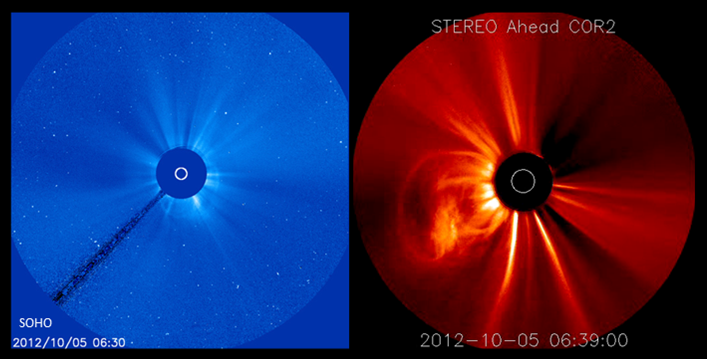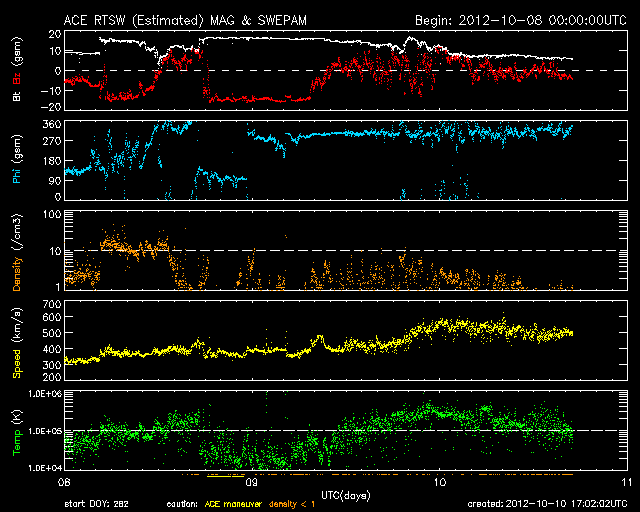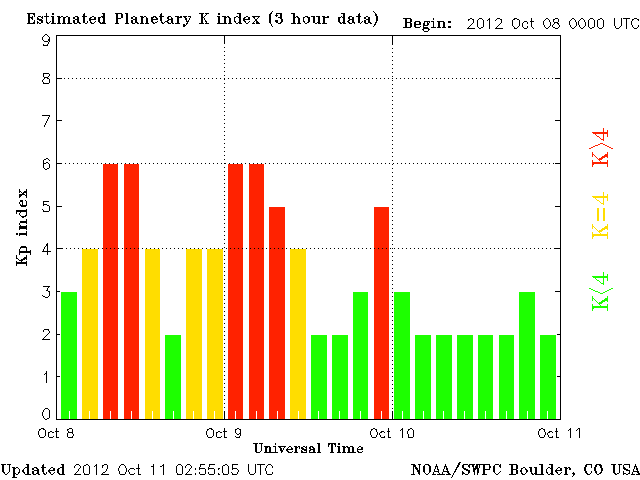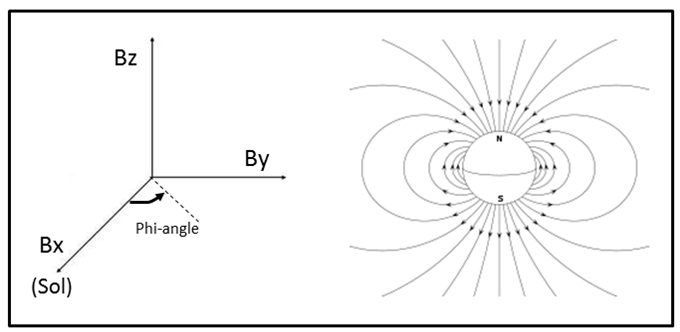
The Solar-Terrestrial Centre of Excellence (STCE) is a collaborative network of the Belgian Institute for Space Aeronomy, the Royal Observatory of Belgium and the Royal Meteorological Institute of Belgium.
 |
Published by the STCE - this issue : 18 Oct 2012. The Solar-Terrestrial Centre of Excellence (STCE) is a collaborative network of the Belgian Institute for Space Aeronomy, the Royal Observatory of Belgium and the Royal Meteorological Institute of Belgium. |
| Archive of the newsletters | Subscribe to this newsletter by mail |
As discussed in the previous STCE Newsletter (http://stce.be/news/163/welcome.html ), the very Long Duration Event from 5 October propelled a coronal mass ejection (CME) towards Earth. From the SOHO (http://sohowww.nascom.nasa.gov/ ) and STEREO (http://stereo.gsfc.nasa.gov/ ) imagery, forecasters concluded that this CME would deliver a glancing blow late on 8 October or on 9 October.

Surprisingly enough, the CME struck already during the early morning hours of 8 October. It had also a very interesting magnetic signature (Bz - red curve in ACE-graph underneath, indicating whether the orientation of the magnetic field is northward or southward). There is a first period having a southward orientation from 4 o'clock till noon, then follows a north-oriented period from noon till 18:00UT, concluded by another southward episode till 7 o'clock on 9 October. After that, the (expected) influence of a coronal hole (CH) can be seen in the slow increase of wind speed (yellow curve) and the (much) higher temperatures (green curve).

Because of the southward direction of the magnetic field, the geomagnetic field experienced moderate storming levels three times: During the morning hours of 8 October, again early on 9 October, and finally late 9 October under the influence of the CH. Thus, the question how *one* CME could produce *two* storm periods begs for an answer.

ACE (http://www.srl.caltech.edu/ACE/ ), the spacecraft that is measuring the solar wind, is located well outside the geomagnetic field. As it recorded these separate periods in the solar wind en route to Earth, the geomagnetic storms had to be a consequence of true changes in the solar wind.
An additional examination of STEREO and SOHO-images by Space Weather forecasters at the STCE revealed there was no other CME involved. But why was this one so early? Scrutiny of the ACE-data indicated there is no doubt that the second period with negative Bz-values is the true CME. That one arrived around 18:00UT, well within the uncertainty limits of the prediction. Forecasters can tell this is the CME because of the low temperature of the particles (i.e. a lot lower than that of the subsequent CH).

The first period with negative Bz-values and the short period with positive Bz-values seem to be embedded in the solar wind. This is not part of the CME, but concerns particles swept up by the shock wave driven by the arriving CME (for another example, see also the 14 July Newsletter: http://stce.be/news/150/welcome.html ). This conclusion is based on the temperature of the particles, which is a lot higher than that inside the CME, as well as on the very erratic behavior of the orientation of the magnetic field in the ecliptic plane (so-called Phi-angle: the blue curve in the ACE-data) during that time frame. The slow solar wind, and the Earth passing through the flank of the CME, may thus explain this lengthy and unusual prologue to the true CME.
Solar activity was moderate during the week, with 3 M-class flares which occurred in two active regions just behind or at the East limb at the time of the events. The strongest event was an M2.3 flare, on Oct 8, 11.17 UT (peak time), which took place in what became NOAA AR 1589 on Oct 10.
Geomagnetic activity was dominated by a period of minor to moderate storm conditions from Oct 8 till Oct 9 at planetary levels. Minor storm conditions (K=5) were observed locally (Dourbes) on Oct 8. This episode was linked to the arrival of a CME, which was observed on Oct. 5. The in-situ measurements showed a rather complex signature of a magnetic cloud, with a 14 hours delay between the first hint of a shock and the cloud itself.
A second period of minor storm conditions was observed from Oct 13 to Oct 14, both at planetary and at local levels (Dourbes). This episode was due to a high speed solar wind stream linked to a small coronal hole.
| DAY | BEGIN | MAX | END | LOC | XRAY | OP | 10CM | TYPE | Cat | NOAA | NOTE |
| 8 | 1105 | 1117 | 1123 | M2.3 | 0 | Partially occulted flare, behind the east limb | |||||
| 9 | 2322 | 2331 | 2335 | S29E86 | M1.7 | 0 | Active region at the east limb, not yet numbered | ||||
| 10 | 0451 | 0504 | 0520 | S29E86 | M1.0 | 0 |
| LOC: approximate heliographic location | TYPE: radio burst type |
| XRAY: X-ray flare class | Cat: Catania sunspot group number |
| OP: optical flare class | NOAA: NOAA active region number |
| 10CM: peak 10 cm radio flux |
Solar Activity
After last week’s low level of activity, the Sun started off with a *Moderate* level activity this week. Two active regions (one north - AR 11589, one south - AR 11590) started being visible on the east limb - and generated one M-flare a day until Wednesday. After that, solar activity went down to *Low*, with a C9.0 flare on Friday.
In order to view the activity of this week in more detail, we suggest to go to the following website from which all the daily (normal and difference) movies can be accessed: http://proba2.oma.be/ssa.
This page also lists the recorded flaring events.
Below are presented some of the events that occurred this week.
October 8th
Several eruptions occurred on the east limb during the day, 1 north and 3 (from the same region) south of the solar equator. One event is shown hereunder (SWAP difference image).

One of the events is shown below (SWAP difference image)

Below is shown a SWAP difference image of the event.

Note, in the image below, the SWAP field of view (yellow) extends further with respect to the AIA 304 FoV (orange).
Invited talk in the session Solar Magnetism and the Solar Cycle.
http://www.spaceweather.eu/en/repository/show?id=253
Presentatie over de 24ste zonnecyclus voor leden van de volkssterrenwacht Urania in het kader van hun wekelijkse voordrachten. Een basiskennis is vereist.
http://www.spaceweather.eu/en/repository/show?id=254
Presentatie over de zon voor leden van de volkssterrenwacht MIRA in het kader van een cursus sterrenkunde. Een basiskennis is vereist.
http://www.spaceweather.eu/en/repository/show?id=255
Talk in the session Solar magnetism and the solar cycle
http://www.spaceweather.eu/en/repository/show?id=256
Talk in the session Solar Magnetism and the Solar Cycle
http://www.spaceweather.eu/en/repository/show?id=257
Talk in the session Solar Magnetism and the Solar Cycle
http://www.spaceweather.eu/en/repository/show?id=258
Talk in the session Solar Magnetism and the Solar Cycle
http://www.spaceweather.eu/en/repository/show?id=259
Talk in the session Solar Magnetism and the Solar Cycle
http://www.spaceweather.eu/en/repository/show?id=260
Talk in the session Processes of slow/steady energy release in the solar atmosphere and heliosphere
http://www.spaceweather.eu/en/repository/show?id=261
Talk in the session Processes of slow/steady energy release in the solar atmosphere and heliosphere
http://www.spaceweather.eu/en/repository/show?id=262
Talk in the session Processes of slow/steady energy release in the solar atmosphere and heliosphere
http://www.spaceweather.eu/en/repository/show?id=263
Talk in the session Processes of slow/steady energy release in the solar atmosphere and heliosphere
http://www.spaceweather.eu/en/repository/show?id=264
Talk in the session Processes of slow/steady energy release in the solar atmosphere and heliosphere
http://www.spaceweather.eu/en/repository/show?id=265
Talk in the session Processes of slow/steady energy release in the solar atmosphere and heliosphere
http://www.spaceweather.eu/en/repository/show?id=266
Invited talk in the session Processes of slow/steady energy release in the solar atmosphere and heliosphere
http://www.spaceweather.eu/en/repository/show?id=267
Invited talk in the session Processes of slow/steady energy release in the solar atmosphere and heliosphere
http://www.spaceweather.eu/en/repository/show?id=268
Talk in the session Processes of slow/steady energy release in the solar atmosphere and heliosphere
http://www.spaceweather.eu/en/repository/show?id=269
Invited talk in the session Eruptive processes in the solar atmosphere and their manifestations in the heliosphere
http://www.spaceweather.eu/en/repository/show?id=270
Talk in the session Eruptive processes in the solar atmosphere and their manifestations in the heliosphere
http://www.spaceweather.eu/en/repository/show?id=271
Talk in the session Eruptive processes in the solar atmosphere and their manifestations in the heliosphere
http://www.spaceweather.eu/en/repository/show?id=272
Invited talk in the session Eruptive processes in the solar atmosphere and their manifestations in the heliosphere
http://www.spaceweather.eu/en/repository/show?id=273
Talk in the session Eruptive processes in the solar atmosphere and their manifestations in the heliosphere
http://www.spaceweather.eu/en/repository/show?id=274
Talk in the session Eruptive processes in the solar atmosphere and their manifestations in the heliosphere
http://www.spaceweather.eu/en/repository/show?id=275
Talk in the session Eruptive processes in the solar atmosphere and their manifestations in the heliosphere
http://www.spaceweather.eu/en/repository/show?id=276
Talk in the session Eruptive processes in the solar atmosphere and their manifestations in the heliosphere
http://www.spaceweather.eu/en/repository/show?id=277
Invited talk in the session Eruptive processes in the solar atmosphere and their manifestations in the heliosphere
http://www.spaceweather.eu/en/repository/show?id=278
Talk in the session Eruptive processes in the solar atmosphere and their manifestations in the heliosphere
http://www.spaceweather.eu/en/repository/show?id=279
Talk in the session Eruptive processes in the solar atmosphere and their manifestations in the heliosphere
http://www.spaceweather.eu/en/repository/show?id=282
Talk in the session Data assimilation, visualization and analysis
http://www.spaceweather.eu/en/repository/show?id=283
Invited talk in session Data assimilation, visualization and analysis
http://www.spaceweather.eu/en/repository/show?id=285
Talk in session Data assimilation, visualization and analysis
http://www.spaceweather.eu/en/repository/show?id=286
Talk in session Data assimilation, visualization and analysis
http://www.spaceweather.eu/en/repository/show?id=287
Talk in session Data assimilation, visualization and analysis
http://www.spaceweather.eu/en/repository/show?id=288
Invited talk in session Data assimilation, visualization and analysis
http://www.spaceweather.eu/en/repository/show?id=289
Invited talk given in the Session Solar Magnetism and the solar cycle
http://www.spaceweather.eu/en/repository/show?id=290
Talk in the session Eruptive processes in the solar atmosphere and their manifestations in the heliosphere.
http://www.spaceweather.eu/en/repository/show?id=291
Talk in session Data assimilation, visualization and analysis
http://www.spaceweather.eu/en/repository/show?id=292
Talk given in the Session Processes of slow/steady energy release in the solar atmosphere and heliosphere
http://www.spaceweather.eu/en/repository/show?id=293
Invited talk in the session Eruptive processes in the solar atmosphere and their manifestations in the heliosphere
http://www.spaceweather.eu/en/repository/show?id=294
Talk in the session Eruptive processes in the solar atmosphere and their manifestations in the heliosphere
http://www.spaceweather.eu/en/repository/show?id=295
Talk in the session Eruptive processes in the solar atmosphere and their manifestations in the heliosphere
http://www.spaceweather.eu/en/repository/show?id=280
The propagation behavior of coronal mass ejections (CMEs) in interplanetary (IP) space is mainly influenced by the ambient solar wind flow. The interaction of CMEs with the solar wind can be expressed as drag force and manifests itself to decelerate CMEs that are faster than the ambient solar wind, whereas slower ones are accelerated until the CME speed is finally adjusted to the solar wind speed. With the SECCHI instrument suite aboard STEREO, CMEs can be observed during their entire propagation way from Sun to 1AU. The derived kinematical profile and its changes may be interpreted as interaction with high speed solar wind streams as well as other coronal mass ejections.
http://www.spaceweather.eu/en/repository/show?id=296
http://www.spaceweather.eu/en/repository/show?id=297
Talk in the session Eruptive processes in the solar atmosphere and their manifestations in the heliosphere
http://www.spaceweather.eu/en/repository/show?id=281
Start : 2013-01-14 - End : 2013-01-17
The Atacama Large Millimeter/submillimeter Array (ALMA), an
international partnership of Europe, North America and East Asia in
cooperation with the Republic of Chile, is the largest astronomical
project in existence.
The workshop aims to bring together the ALMA-minded solar
community to discuss solar observational issues with ALMA, solar
science and planned observations with ALMA, and the planning of
solar ALMA observations.
Th workshop is hosted by Astronomy & Astrophysics Group,
and will take place in School of Physics and Astronomy, University
of Glasgow, Room 323, Kelvin Building.
Website:
http://www.astro.gla.ac.uk/~eduard/solarALMA/
Start : 2013-04-08 - End : 2013-04-12
The most recent solar minimum, solar cycle 23-24 minimum, was
unusually long (266 spotless days in 2008, the most since 1913),
and the magnetic field at the solar poles was approximately 40%
weaker than the last cycle; and unusually complex (the solar wind
was characterized by a warped
heliospheric current sheet, HCS, and fast-wind
streams at low latitudes: the
fast-wind
threads the ecliptic
more commonly in 2008 than 1996.)
This complexity resulted in many effects observed from Sun to
Earth, with many observations indicating unusual conditions on the
Sun, in the heliosphere
, and in the magnetosphere
, ionosphere
, and upper atmosphere of the
Earth.
This remarkable set of conditions provide the scientific
community with an exceptional opportunity to assess the nature and
structure of a very quiet Sun, and an upper atmosphere relatively
devoid of solar influences, helping to provide a better
understanding of the relative roles of solar activity and internal
variability in the dynamics of the Earth's upper atmosphere and
ionosphere
. Such an understanding requires a
multidisciplinary approach.
The main goal of the conference is to bring together the solar,
heliospheric, magnetospheric, upper atmosphere, and ionospheric
communities to debate and discuss interdisciplinary work and reach
a better understanding of the nature and structure of a very quiet
Sun, and of an upper atmosphere relatively devoid of solar
influences, and in doing so, to help clarify the role of solar
activity in the dynamics and variability of the Earth's upper
atmosphere and ionosphere
relative to the internal
variations.
Website:
http://chapman.agu.org/solarminimum/
Start : 2013-05-06 - End : 2013-05-10
In the last 50 years, helioseismology has made significant
contributions to the knowledge of the Sun's interior physics
and has led the way to asteroseismology. We have now reached an era
where more sophisticated questions are being asked to understand
the subtle properties of the Sun and other stars due to the
synoptic and high-resolution observations available from BISON,
GONG and space missions such as SOHO
, SDO, CoRot and Kepler.
On this occasion, a workshop on the theme of '50 years of the
seismology of the Sun and stars' is being organized to reflect the
progress that has been made as well as to focus on future goals. We
plan to bring together helio- and asteroseismologists, theorists
and observers in a journey that will take us from the interior of
the Sun and its magnetism towards the structure of distant stars
and activity cycles.
Website:
http://www.nso.edu/workshops/2013